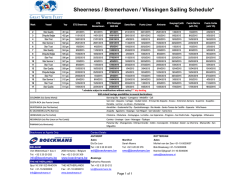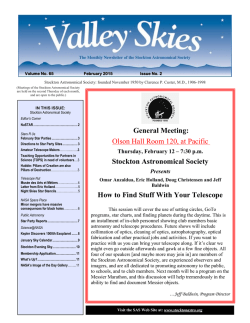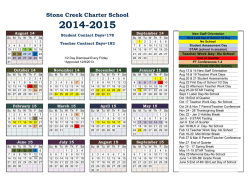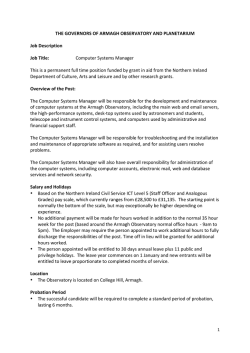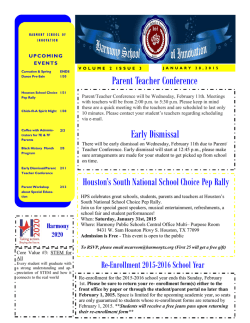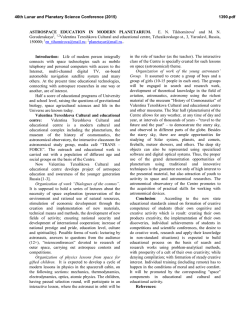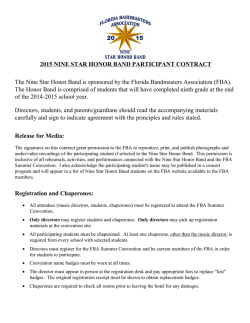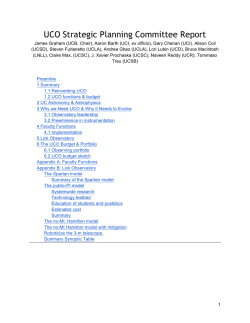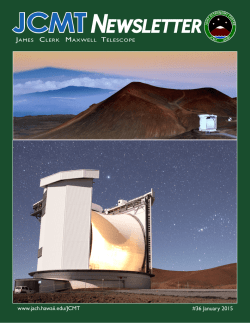
Guidestar: February, 2015 - Houston Astronomical Society
Houston Astronomical Society Page 1 February, 2015 February, 2015 Volume 34, #2 At the February 6 Meeting Highlights: Novice-Observing and Imaging Jupiter 3 President’s Message 4 Brian Cudnik, HAS Member Minor Mergers—Big Consequences 8 Brian will describe the status of our search for our "home away from home" in another planetary system. This presentation will include a brief introduction to exoplanets, along with some visualization of what they may look like, with an emphasis on Earth-like worlds around other stars. I will share the latest score on how many planets we have found and highlight some of the most interesting multi-planet systems that the Kepler satellite has found to date. Adrift: Does America Have a Future in Space 9 Other Suns, Other Earths Brian is a HAS member and former program chair. He is also the author of two books, Faint Objects and How to Observe Them, and Lunar Meteoroid Impacts and How to Observe Them. Star's Spins Reveals Their Ages 10 Craig Nance - New at McDonald Obs. 11 Black Holes Choke on Swallowed Star 12 Rigel—Beta Orionus 14 HAS Web Page: http://www.AstronomyHouston.org See the GuideStar's Monthly Calendar of Events to confirm dates and times of all events for the month, and check the Web Page for any All meetings are at the University of Houston Science and Research building. See the last page for directions to the location. Novice meeting: ······················ 7:00 p.m. Bill Flanagan — “Observing and Imaging Jupiter” The GuideStar is the winner of the 2012 Astronomical League Mabel Sterns Newsletter award. General meeting: ···················· 8:00 p.m Brian Cudnik — “Other Suns Other Earths” See last page for directions The Houston Astronomical Society is a member of the Astronomical League. and more information. February, 2015 Page 2 The Houston Astronomical Society The Houston Astronomical Society is a non-profit corporation organized under section 501 (C) 3 of the Internal Revenue Code. The Society was formed for education and scientific purposes. All contributions and gifts are deductible for federal income tax purposes. General membership meetings are open to the public and attendance is encouraged. Officers President Rene Gedaly [email protected] C: 281-300-3559 Vice President John Haynes [email protected] Secretary Bill Flanagan [email protected] 713-699-8819 Treasurer Don Selle [email protected] Directors at Large Ash Alashqar [email protected] Mark Holdsworth [email protected] H:713-478-4109 Jessica Kingsley, [email protected] Debbie Moran [email protected] H:713-774-0924, C:713-562-7670 Bram Weisman [email protected] Bill Pellerin (Past president) C:713-598-8543 Ad-Hoc Committee Chairpersons AL Coordinator Doug McCormick [email protected] Audio/Visual Michael Rapp [email protected] GuideStar Bill Pellerin C:713-598-8543 Texas 45 Coordinator Rene Gedaly [email protected] Texas Star Party Steve Goldberg H: 713-721-5077 Video Rob Morehead [email protected] Webmaster Jeffrey McLaughlin [email protected] Advisors Dr. Reginald DuFour Rice University Dr. Lawrence Pinsky University of Houston Dr. Lawrence Armendarez University of St. Thomas Annual Dues and Membership Information Committee Chairpersons Audit Scott Mitchell H:281-293-7818 Education & Outreach Bram Weisman [email protected] Regular $36 Associate $6 Sustaining $50 Student $12 n/c Field Tr./Obsg Stephen Jones [email protected] Honorary Membership Steve Fast [email protected] 713-898-2188 Novice Debbie Moran [email protected] H:713-774-0924, C:713-562-7670 Observatory Mike Edstrom [email protected] 832-689-4584 All members have the right to participate in Society functions and to use the Observatory Site. Regular and Student Members receive a subscription to The Reflector. The GuideStar, the monthly publication of the Houston Astronomical Society is available on the web site. Associate Members, immediate family members of a Regular Member, have all membership rights, but do not receive publications. Sustaining members have the same rights as regular members with the additional dues treated as a donation to the Society. Sky & Telescope and Astronomy magazines are available to members at a discount. Program Justin McCollum [email protected] Publicity Bram Weisman [email protected] Telescope Allen Wilkerson [email protected] 832- 265-4773 Membership Application: Send funds to address shown on last page of GuideStar. Attention - Treasurer, along with the following information: Name, Address, Phone Number, Special Interests in Astronomy, Do you own a Telescope? (If so, what kind?), and where you first heard of H.A.S. You can also join (or renew at the organization web site, www.astronomyhouston.org. February, 2015 Page 3 Table of Contents Other Meetings... 3 ...... Observing and Imaging Jupiter 4 ...... President's Message 5 ...... February/March Calendar 6 ...... Observations of the Editor 7 ...... Observatory Corner 8 ...... Minor Mergers - Big Consequences 9 ...... Adrift: Does America Have a Future in Space? ...... Jeff Goldstein, Astrogizmos 10 ...... Star's Spins Reveals Their Ages 11 ...... Craig Nance - New at McDonald Observatory 12 ...... Black Hole Chokes on Swallowed Star 14 ...... Rigel-Beta Orionis GuideStar deadline for the March issue is February 15th Johnson Space Center Astronomical Society meets in the the Lunar and Planetary Institute on the 2nd Friday of each month. Web site: www.jscas.net Fort Bend Astronomy Club meets the third Friday of the month at 8:00 p.m. at the Houston Community College Southwest Campus in Stafford, Texas http://www.fbac.org/club_meetings.htm. Novice meeting begins at 7:00 p.m., regular meeting begins at 8:00 p.m. Website: http://www.fbac.org North Houston Astronomy Club meets at 7:30 p.m. on the 4th Friday of each month in the Teaching Theatre of the Student Center at Kingwood College.Call 281-312-1650 or [email protected]. Web site: www.astronomyclub.org Brazosport Astronomy Club meets the third Tuesday of each month at the Brazosport planetarium at 7:45 p.m. The Brazosport planetarium is located at 400 College Boulevard, Clute, TX, 77531. For more information call 979-265-3376 Novice Presentation—February 6, 2015 Observing and Imaging Jupiter By Debbie Moran The February 6th meeting occurs just as Jupiter is reaching opposition or the closest point in its orbit to us. Expert planetary imager Bill Flanagan will speak on “Observing Jupiter” and tell us everything you wanted to know about Jupiter as well as introduce you to what is involved in becoming a good planetary imager. In the future we will look at having a more detailed talk dedicated to planetary imaging. Bill Spizzirri will be the speaker In March with a talk about the Milky Way galaxy. Image of Jupiter on right by Bill Flanagan..November 5, 2011, UT 04:59 February, 2015 Page 4 President’s Message by Rene Gedaly, President B ad weather finally worked to the amateur astronomer’s advantage last January. Instead of convening at the HAS Observatory, pouring rain allowed 22 members of the leadership team to meet at the home of Debbie Moran for our first annual leadership meeting. HAS at a glance Treasurer Don Selle kicked off the meeting with a financial snapshot of our economic health; HAS is in good shape. Webmaster Jeffery McLaughlin pulled back the curtain to show us the inner workings of the website and took enhancement requests, prioritizing them into quick fixes and those for future development. Rob Morehead showed us SlidesLive, the technology he uses to turn video recordings into speaker presentations that he posts on the website. Rob said the presentations have racked up an impressive 1,000 views by HAS members since he started recording just one year ago. And as the committee chairs shared status and vision for their specific areas, the meeting format quickly changed into a high energy discussion of where the society could improve and evolve. At the board meeting that followed, we formed ad hoc committees for Long Range Planning and Development. Ed Fraini and Clayton Jeter will be fleshing out ideas as part of Long Range Planning and Don Selle is heading up Development. HAS members have long been generous with fundraising, and in that tradition Don and his committee will be putting in place a formal structure for planned giving. I also want to introduce you to new board member Jessica Kingsley. Jessica has jumped in wherever needed, taking meeting minutes, and in future months, will be setting up a/v equipment and video recording talks when Michael Rapp and Rob Morehead are out of town. Leadership Initiatives Ideas discussed during the meeting were quickly translated into action. Bram Weisman kicked off Publicity by setting up an HAS Facebook group which is already getting some traction. Only half of HAS members subscribe to the email list, so Bram is hoping to catch the younger crowd with Facebook. Potential new members can find us on Facebook, but the group itself is open to HAS members only. Take a look here and consider joining: https://www.facebook.com/groups/ AstronomyHouston/. Stephen Jones, Field Trip & Observing, already has a year’s worth of activities planned. He’s been announcing them via the list server but has also updated the website calendar with star parties, a Messier Marathon, and picnics. He hasn’t missed a beat, caravaning groups out to the dark site and generating a lot of momentum as a result. If you’re on the email list, you’ve seen the number of members using the list to plan meet ups at the dark site. Backyard observing appears on the rise as well. Bram has put together his recognition list of members that have been active in outreach activities over the past year. The pins he awards are from the Night Sky Network and this year’s emblem is 2015: International Year of Light. HAS will again participate in the Science Engineering Fair as a Special Awarding Agency in Physics & Astronomy. Debbie Moran is coordinating this effort and will serve as the head judge for HAS. The Program chair is a big position to fill but Justin McCollum already has a good part of the year’s programming either nailed down or in the works. His plans for the December meeting promise to be a change of pace and a lot of fun befitting the season. Your 2015 Leadership I had high hopes for this leadership meeting. It’s a good team to be sure and the contribution of many go unnamed at present. Just know, as I learned, that there’s no overestimating the transformative power of a group so passionate about astronomy and HAS. Keep Looking Up ..Rene Gedaly President February, 2015 Page 5 February/March Follow the GuideStar on Twitter at: Calendar Date Time GuideStar_HAS Event February 3 6 11 14 18 25 8 13 20 21 27 Houston Astronomical Society Starline 5:09 p.m. 12:00 p.m. 7:00 p.m. 8:00 p.m. 9:50 p.m. Full Moon Jupiter at opposition HAS Novice Meeting, U of H HAS General Meeting, U of H Last Quarter Moon Prime Night, Columbus Site 5:47 p.m. 11:14 a.m. New Moon First Quarter Moon 12:05 p.m. 7:00 p.m. 8:00 p.m. 2:00 a.m. Full Moon HAS Novice Meeting, U of H HAS General Meeting, U of H DST begins, move clock forward 1 hr. Last Quarter Moon New Moon Spring equinox Prime Night, Columbus Site First Quarter Moon March 5 6 Join Facebook and look for: 11:48 a.m. 3:38 a.m. 4:45 p.m. 1:43 a.m. Send calendar events to Doug McCormick [email protected] For the latest information on club events, go to http://www.astronomyhouston.org/ Call 832-go4-HAS0 (832-464-4270) for the latest information on the meeting and other information about activities within the HAS. Event Notification or Cancellation HAS uses RAINEDOUT.NET to communicate late breaking updates about our various events. . Message delivery is via text messaging and e-mail. There are several ways to subscribe. If you would like to receive these notices via text messaging directly to your phone, subscribe to any of the sub-groups which interest you as follows: To receive text messages, send any or all of the following (one at a time) to 84483 You will receive a confirmation message back for each successful enrollment. Text Message Alerts about... OUTREACH Public Outreach Events STARPARTY Members Only Star Parties (HAS observing site) URBAN Urban Observing Events MEETINGS HAS Meetings You may also enroll your phone numbers or individual e-mail addresses via the website: HAS Board Meeting HAS Board meetings are scheduled regularly (see the calendar, above). All members are invited to attend these meetings, but only board members can vote on issues brought before the board. Meetings are held at the Houston Arboretum at 7:00 p.m. on the date specified. Here's a shortened link to get you there: http://goo.gl/evrGsR For more information, please visit www.RainedOut.net. RainedOut notices will also automatically be sent to our e-mail list. Note that regular e-mail list conversations are not part of RainedOut communications and will not be sent to your phone as part of this service. Instructions to sign up for the e-mail list (a great way to keep your finger on the pulse of the club) are found here: http://www.astronomyhouston.org/about/email-list. February, 2015 Page 6 Observations... of the editor by Bill Pellerin, GuideStar Editor Oops… Alpha Com—no eclipse In this GuideStar My ‘ Shallow Sky’ object of the month in January was Alpha Com. There was reported to be an eclipse of the star by its companion which would cause the star to dim by .7 magnitude (from 4.2 magnitude). Rene Gedaly in her ‘President’s Message’ talks about her vision for the organization and the outcome of a leadership meeting held in January. You can be a part of this by volunteering to participate in the HAS. It turns out that this eclipse didn’t happen as reported. The astronomers who announced this event found out that some of the data they had was misinterpreted. They confused the primary and the secondary star in some old data and the timing of the event was incorrect. I was doing some work to capture this event by making photometric measurements of the star during the period in which the eclipse was supposed to take place. There was a bit of effort devoted to resolving various issues, including: What would the exposure required to get good data on the star? Answer: .1 sec What comparison stars are in the field of the imager and if we image in B (Blue), R (Red), and V (visual), is there BVR magnitude data for the comp star? Answer: only one, and with BVR data at the AAVSO web site. What resolution in time is required to characterize this eclipse? That is, what is the interval between exposures when the star is in the sky? Answer: three to five images per hour should be enough. Can we analyze the data using the AAVSO VPHOT analyzing capability? Answer: yes, but given the amount of data it might make sense to analyze it locally and report only the results to AAVSO. Is this star in the AAVSO database? Answer: yes Since we’ll produce a lot of images (data) how do we manage the data? Answer: crop the images during post processing to reduce the file size; also do image stacking at the telescope to reduce the amount of data that has to be transmitted over the Internet. ...and so on. All these questions are moot now that the eclipse event isn’t going to happen as originally scheduled. It was an interesting exercise, anyway, and next time an event like this comes around we’ll be ready. Personally, I’m continuing to get data on R Crb (type) stars and report the results to the AAVSO. There are lots of interesting stars and types to observe. Check it out at www.aavso.org. This month’s Shallow Sky object isn’t one that’s going to go away soon — it’s Rigel. You might think that there’s not much to say about this star, but check it out. Be sure to read Mike Edstrom’s ‘Observatory Corner’ article. The rate of change at the observatory site has been amazing. Private observatories are being built and used by our members and site amenities are significantly improved. There’s an article from the AAVSO writer’s bureau on black holes, and two articles from the McDonald Observatory—one introducing the new superintendent of the McDonald Observatory and the other on what happens as a black hole consumes a star. Until next time... clear skies and new moons! ..Bill February, 2015 Page 7 Observatory Corner By Mike Edstrom, Observatory Director I t is time for the gate combination change and I will be changing the combination on February 28, 2015 please be sure to see me at the February 6th meeting to get your 2015 code. We will soon be putting the site orientation program on the website. In doing so we are going to ask everyone who already has taken the course to take a refresher course. When you complete the course and pass the 10 or so question quiz the data base will automatically be updated and there will no longer be a question as to whether the data base is correct and we will be able to e-mail any changes in access to the site. I will be sending out an announcement on the list server when the online course is available, thank you for your assistance in getting our data base corrected. We will be presenting a proposal to the HAS Board of Directors to add another 12 Private Observatory sites on the west side of the big observatory soon. Anyone interested in a Private Observatory site needs let me know so I can put you on a “Waiting” list for new sites. We are coming into peak observing time of the year with the first cool front now is the time to take advantage of HAS’s most valued asset, the Dark Site. Please remember to fill out your observing log and put it in the center box on the observing field. As you visit the Dark Site we invite you to make suggestions as to improvements you would like to see please put the on the log sheets. As a safety reminder please read the sign posted on the side of the metal building at the Dark Site which has directions to the hospital and contact information for the sheriff’s department it also has the address to the site in case of a medical emergency. And the Work Goes On I need to remind everyone that we need to start filling out Log Reports at the site so I can give this information to the Fondren Foundation. The property is on a 99 year lease and part of the Lease agreement is that HAS needs to report every year to the Fondren Foundation that the property is being used. The Log Reports are located in the box in the middle of the field. Just open the cover, fill out the report and then slide it into the slot that is in the inside of the cover and then close the box. It is very important that everyone fill out a Log Report so that we are showing that the Observing site is being used. Your help on this is very much appreciated. If you have a Randalls card, and have not done so, please have it coded for the Houston Astronomical Society. Our number is #6618. The Society gets 1% of the gross sales that member spends at Randalls. Randalls totals up the amount spent each quarter and will send us a check if the amount goes over $2,500, otherwise the total roles over to the next quarter of zeros out at the end of the calendar year. So please link your Randalls card to the Houston Astronomical Society so that the society can benefit from this Randalls program. This is very easy to do, just go to the Courtesy Booth and tell the person there what you want to do. Mike Edstrom Observatory Chairman [email protected] [email protected] February, 2015 Page 8 Minor Mergers Have Massive Consequences for Black Holes By Dr. Ethan Siegel W hen you think of our sun, the nearest star to our world, you think of an isolated entity, with more than four light years separating it from its next nearest neighbor. But it wasn't always so: billions of years ago, when our sun was first created, it very likely formed in concert with thousands of other stars, when a giant molecular cloud containing perhaps a million times the mass of our solar system collapsed. While the vast majority of stars that the universe forms—some ninety-five percent—are the mass of our sun or smaller, a rare but significant fraction are ultra-massive, containing tens or even hundreds of times the mass our star contains. When these stars Images credit: NGC 3393 in the optical (L) by M. Malkan (UCLA), HST, NASA (L); NGC 3393 in the X-ray and optical (R), composite by NASA / CXC / SAO / G. Fabbiano et al. (X-ray) and NASA/STScI (optical). run out of fuel in their cores, they explode in a fantastic Type II supernova, where the star's core collapses. In the most massive cases, this forms a black hole. Over time, many generations of stars—and hence, many black holes—form, with the majority eventually migrating towards the centers of their host galaxies and merging together. Our own galaxy, the Milky Way, houses a supermassive black hole that weighs in at about four million solar masses, while our big sister, Andromeda, has one nearly twenty times as massive. But even relatively isolated galaxies didn't simply form from the monolithic collapse of an isolated clump of matter, but by hierarchical mergers of smaller galaxies over tremendous timescales. If galaxies with large amounts of stars all have black holes at their centers, then we should be able to see some fraction of Milky Way-sized galaxies with not just one, but multiple supermassive black holes at their center! It was only in the early 2000s that NASA's Chandra X-ray Observatory was able to find the first binary supermassive black hole in a galaxy, and that was in an ultra-luminous galaxy with a double core. Many other examples were discovered since, but for a decade they were all in ultra-massive, active galaxies. That all changed in 2011, with the discovery of two active, massive black holes at the center of the regular spiral galaxy NGC 3393, a galaxy that must have undergone only minor mergers no less than a billion years ago, where the black hole pair is separated by only 490 light years! It's only in the cores of active, Xray emitting galaxies that we can detect binary black holes like this. Examples like NGC 3393 and IC 4970 are not only confirming our picture of galaxy growth and formation, but are teaching us that supermassive relics from ancient, minor mergers might persist as standalone entities for longer than we ever thought! Check out some cool images and artist reconstructions of black holes from Chandra: http://chandra.harvard.edu/photo/category/ blackholes.html Kids can learn all about Black Holes from this cool animation at NASA’s Space Place: http://spaceplace.nasa.gov/black-holes. Page 9 February, 2015 March Presentation Adrift: Does America Have a Future in Space? Eric Berger — Science Writer of the Houston Chronicle O ver the course of 2014 science writer Eric Berger looked at NASA’s building of a big new rocket, the collapse of the Constellation program, Congressional infighting for funds, shifting priorities of successive White House administrations, the promise of private space companies and, ultimately, the fate of Houston as Space City. This presentation is about what he found. Bio: Eric Berger is the science writer for the Houston Chronicle. For his coverage of Hurricane Ike the Chronicle was a Pulitzer Prize finalist in 2009. He would like to see humans on Mars in his lifetime. Jeff Goldstein, Astrogizmos By Jeff Norwood, Camera Concepts I t is with a heavy heart and the greatest of sorrow that I must inform you of the passing away of one of our colleagues: Jeff Goldstein, the owner of Astrogizmos. Jeff was an incredibly hard working man and an indefatigable supporter of many astronomical organizations across the country for the past ten years. Unbeknownst to many people, Jeff was a fascinating individual who was accomplished in a wide variety of fields. Besides being an entrepreneur and innovator, Jeff was also a full registered nurse, a computer specialist for Hewlett-Packard with Microsoft Certified Certificates in all aspects of computer science, and had even completed his full Jurist Doctorate of Law and all of this done in what would be much too short a life. He was a generous individual who was always willing to lend anyone a helping hand and I considered him a very close friend. Jeff is survived by wife, Jean; his two sons, Charles and Craig; and (God bless her) his mother, Gladys. I ask all of you to pass the word to others in the astronomical community. Our star parties, I'm afraid, will be a bit less exciting without him: he will be sorely missed. Anyone wishing to send condolences to Jeff's wife, Jean, may reach her [email protected]. February, 2015 Page 10 Stars' Spins Reveal Their Ages From the Harvard-Smithsonian Center for Astrophysics , Cambridge MA W hen you're a kid every birthday is cause for celebration, but as you get older they become a little less exciting. You might not want to admit just how old you are. And you might notice yourself slowing down over the years. You're not alone the same is true of stars. They slow down as they age, and their ages are well-kept secrets. Astronomers are taking advantage of the first fact to tackle the second and tease out stellar ages. "Our goal is to construct a clock that can measure accurate and precise ages of stars from their spins. We've taken another significant step forward in building that clock," says Soren Meibom of the Harvard-Smithsonian Center for Astrophysics (CfA). Meibom presented his team's findings today in a press conference at a meeting of the American Astronomical Society. Their results mark the first extension of such observations to stars with ages beyond 1 billion years, and toward the 4.6-billion-year age of the Sun. Being able to tell the ages of stars is the basis for understanding how astronomical phenomena involving stars and their companions unfold over time. Knowing a star's age is particularly relevant to the search for signs of alien life outside our solar system. It has taken a long time for life on Earth to attain the complexity we find today. With an accurate stellar clock, astronomers can identify stars with planets that are as old as our Sun or older. A star's spin rate depends on its age because it slows down steadily with time, like a top spinning on a table. A star's spin also depends on its mass; astronomers have found that larger, heavier stars tend to spin faster than smaller, lighter ones. This new work shows that there is a close mathematical relationship between mass, spin, and age so that by measuring the first two, scientists can calculate the third. "We have found that the relationship between mass, rotation rate and age is now defined well enough by observations that we can obtain the ages of individual stars to within 10 percent," explains co-author Sydney Barnes of the Leibniz Institute for Astrophysics in Germany. Barnes first proposed this method in 2003, building on prior work, and called it gyrochronology from the Greek words gyros (rotation), chronos (time/age), and logos (study). To measure a star's spin, astronomers look for changes in its brightness caused by dark spots on its surface - the stellar equivalent of sunspots. Unlike our Sun, a distant star is an unresolved point of light so astronomers can't directly see a sunspot cross the stellar disk. Instead, they watch for the star to dim slightly when a sunspot appears, and brighten again when the sunspot rotates out of view. These changes are very difficult to measure because a typical star dims by much less than 1 percent, and it can take days for a sunspot to cross the star's face. The team achieved the feat using data from NASA's Kepler spacecraft, which provided precise and continuous measurements of stellar brightnesses. For gyrochronology ages to be accurate and precise, astronomers must calibrate their new clock by measuring the spin periods of stars with both known ages and masses. Meibom and his colleagues previously studied a cluster of billion-year-old stars. This new study examines stars in the 2.5-billion-year-old cluster known as NGC 6819, thereby significantly extending the age range. "Older stars have fewer and smaller spots, making their periods harder to detect," says Meibom. The team examined stars weighing 80 to 140 percent as much as the Sun. They were able to measure the spins of 30 stars with periods ranging from 4 to 23 days, compared to the present (Continued on page 13) February, 2015 Page 11 Craig Nance — New Superintendent of McDonald Observatory near Fort Davis F ORT DAVIS — Craig Nance begins his tenure as Superintendent of McDonald Observatory today. The Superintendent is the on-site manager of the Observatory. “Craig brings strong management experience, extensive engineering background, love of astronomy, and excellent performance in a very similar position,” at Mount Graham International Observatory, said McDonald director Dr. Taft Armandroff. “It’s a tremendous opportunity,” Nance said. “McDonald is part of the Trans-Pecos community. It’s a community-wide asset. That’s foremost in my mind,” he said. “I want to see McDonald grow and prosper for all of its stakeholders, whether they be astronomers, visitors, or teachers.” Nance said he will work with Armandroff on the director’s three main goals, which include insuring the sustainability of McDonald Observatory, getting the HobbyEberly Telescope Dark Energy Experiment (HETDEX) under way at McDonald, and the Observatory’s role in the forthcoming Giant Magellan Telescope. The University of Texas at Austin McDonald Observatory near Fort Davis, Texas, hosts multiple telescopes undertaking a wide range of astronomical research under the darkest night skies of any professional observatory in the continental United States. McDonald is home to the consortium-run Hobby-Eberly Telescope (HET), one of the world's largest, which is now being upgraded to begin the HET Dark Energy Experiment. An internationally known leader in astronomy education and outreach, McDonald Observatory is also pioneering the next generation of astronomical research as a founding partner of the Giant Magellan Telescope. Courtesy The University of Texas at Austin McDonald Observatory, publisher of StarDate magazine http://stardate.org/magazine “Those three things are directly related to what’s going on in West Texas,” Nance said. “I look forward to leading the staff there, leading that vision.” Nitrogen Tank Installation at the Hobby-Eberly Telescope Nance comes to McDonald from The University of Arizona’s Mount Graham International Observatory, where he has served as director. Prior to that, he was Operations Engineering Manager at the W. M. Keck Observatory in Hawaii, where he worked with Armandroff. From 1997 to 2000, Nance worked at McDonald Observatory. Among other positions, he served as Facility Manager of the Hobby-Eberly Telescope. See the latest installation video, the nitrogen tank installation. Have a look at (click link or copy URL to browser): https://www.youtube.com/watc h?feature=player_embedded&v=2a1xZF1b 0wQ. “It’s great to return to McDonald Observatory,” he said. “My wife Laura and I are really excited to return to West Texas. We were married in Marfa, and have relatives in the area,” he noted. Nance replaces outgoing Superintendent Dr. Tom Barnes, who is retiring from McDonald Observatory after more than 40 years, the last five as Superintendent. February, 2015 Page 12 Black Hole Chokes on a Swallowed Star The University of Texas at Austin McDonald Observatory F ORT DAVIS, Texas — A five-year analysis of an event captured by a tiny telescope at McDonald Observatory and followed up by telescopes on the ground and in space has led astronomers to believe they witnessed a giant black hole tear apart a star. The work is published this month in The Astrophysical Journal. On January 21, 2009, the ROTSE IIIb telescope at McDonald caught the flash of an extremely bright event. The telescope’s wide field of view takes pictures of large swathes of sky every night, looking for newly exploding stars as part of the ROTSE Supernova Verification Project (RSVP). Software then compares successive photos to find bright “new” objects in the sky — transient events like the explosion of a star or a gamma-ray burst. With a magnitude of -22.5, this 2009 event was as bright as the “superluminous supernovae” (a new category of the brightest stellar explosions known) that the ROTSE team discovered at McDonald in recent years. The team nicknamed the 2009 event “Dougie,” after a character in the cartoon South Park. (Its technical name is ROTSE3J120847.9+430121.) When a star encounters a black hole, tidal forces stretch the star into an elongated blob before tearing it apart, as seen in these images from a computer simulation by James Guillochon of Harvard University. Click to view animation on YouTube. The team thought Dougie might be a supernova, and set about looking for its host galaxy (which would be much too faint for ROTSE to see). They found that the Sloan Digital Sky Survey had mapped a faint red galaxy at Dougie’s location. The team followed that up with new observations of the galaxy with one of the giant Keck telescopes in Hawaii, pinpointing the galaxy’s distance at three billion lightyears. These deductions meant Dougie had a home — but just what was he? Team members had four possibilities: a superluminous supernova; a merger of two neutron stars; a gamma-ray burst; or a “tidal disruption event” — a star being pulled apart as it neared its host galaxy’s central black hole. To narrow it down, they studied Dougie in various ways. They made ultraviolet observations with the orbiting Swift telescope, and took many spectra from the ground with the 9.2-meter HobbyEberly Telescope at McDonald. Finally, they used computer models of how the light from different possible physical processes that might ROTSE IIIb telescope at the explain how McDonald Observatory Dougie would behave — how it varies in brightness over time, and what chemical signatures it might show — and compared them to Dougie’s actual behavior. In detail, Dougie did not look like a supernova. The neutron star merger and gammaray burst possibilities were similarly eliminated. "When we discovered this new object, it looked similar to supernovae we had known already,” said lead author Jozsef Vinko of the University of Szeged in Hungary. “But when we kept monitoring its light variation, we realized that this was something nobody really saw before. Finding out that it was probably a supermassive black hole eating a star was a fascinating experience,” Vinko said. Team member J. Craig Wheeler, leader of the supernova group at The University of Texas at Austin, elaborated. “We got the idea that it might be a ‘tidal disruption’ event,” he said, explaining that means that the enormous gravity of a black hole pulls on one side of the star harder than the other side, creating tides that rip the star apart. “A star wanders near a black hole, the star’s side nearer the black hole is pulled” (Continued on page 13) February, 2015 Page 13 (Continued from page 10) (Continued from page 12) 26-day spin period of the Sun. The eight stars in NGC 6819 most similar to the Sun have an average spin period of 18.2 days, strongly implying that the Sun's period was about that value when it was 2.5 billion years old (about 2 billion years ago). on more than the star’s far side, he said. “These especially large tides can be strong enough that you pull the star out into a noodle” shape. The team then evaluated several existing computer models that calculate the spin rates of stars based on their masses and ages, and determined which model best matched their observations. "Now we can derive precise ages for large numbers of cool field stars in our Galaxy by measuring their spin periods," states Meibom. "This is an important new tool for astronomers studying the evolution of stars and their companions, and one that can help identify planets old enough for complex life to have evolved." This work was first published online on the website of the journal Nature on January 5, 2015. It is part of the broader Kepler Cluster Study, for which Meibom is the principal investigator. More information is available at: https://www.cfa.harvard.edu/~smeibom/. A video pertaining to these results can be found here. Headquartered in Cambridge, Mass., the HarvardSmithsonian Center for Astrophysics (CfA) is a joint collaboration between the Smithsonian Astrophysical Observatory and the Harvard College Observatory. CfA scientists, organized into six research divisions, study the origin, evolution and ultimate fate of the universe. For more information, contact: David A. Aguilar Director of Public Affairs Harvard-Smithsonian Center for Astrophysics 617-495-7462 [email protected] Christine Pulliam Public Affairs Specialist Harvard-Smithsonian Center for Astrophysics 617-495-7463 [email protected] This content distributed by the AAVSO Writer's Bureau The star “doesn’t fall directly into the black hole,” Wheeler said. “It might form a disk first. But the black hole is destined to swallow most of that material.” Though astronomers have seen black holes swallow stars before — though less than a dozen times — this one is special even in that rare company: It’s not going down easy. Models by team members James Guillochon of Harvard and Enrico Ramirez-Ruiz at the University of California, Santa Cruz, showed that the disrupted stellar matter was generating so much radiation that it pushed back on the infall. The black hole was choking on the rapidly infalling matter. Based on the characteristics of the light from Dougie, and their deductions of the star’s original mass, the team has determined that Dougie started out as a Sun-like star, before being ripped apart. Their observations of the host galaxy, coupled with Dougie’s behavior, led them to surmise that the galaxy’s central black hole has the “rather modest” mass of about a million Suns, Wheeler said. Delving into Dougie’s behavior has unexpectedly resulted in learning more about small, distant galaxies, Wheeler said, musing “Who knew this little guy had a black hole?” The paper’s lead author, Jozsef Vinko, began the project while on sabbatical at The University of Texas at Austin. The team also includes Robert Quimby of San Diego State University, who started the search for supernovae using ROTSE IIIb (then called the Texas Supernova Search, now RSVP) and discovered the category of superluminous supernovae while a graduate student at The University of Texas at Austin. Science contacts: Dr. J. Craig Wheeler, Samuel T. and Fern Yanagisawa Regents Professor in Astronomy The University of Texas at Austin 512-471-6407; [email protected] Dr. Jozsef Vinko, Assoc. Professor of Astronomy University of Szeged, Hungary [email protected] Courtesy The University of Texas at Austin McDonald Observatory, publisher of StarDate magazine http://stardate.org/magazine February, 2015 Page 14 Shallow Sky Object of the Month Rigel—Beta Orionis By Bill Pellerin, GuideStar Editor Finder chart, north is up. Object: Rigel—Beta Orionis Class: Blue giant star Magnitude: 0.13 R.A.: 5 h, 14 m, 32 s Dec: -8 degrees, 12 minutes, 06 seconds Distance: 860 ly Constellation: Orion Spectral: B8 Optics needed: Unaided eye Why this object is interesting: The constellation of Orion is a telecope magnet, drawing telescopes to the bright stars and bright nebula it contains. Rigel is probably the second most well known star in the constellation, behind Betelgeuse, and while Rigel is the ‘beta’ star in the constellation it is sometimes brighter than its better known companion. It’s easy to find, so easy that I considered leaving out the finder chart, and it’s well placed for observers at this time of the year. Rigel transits at 19:46 and sets at 01:33 on the 18th of February, the day of the new moon. Star charts generated by TheSkyX © Software Bisque, Inc. All rights reserved. www.bisque.com Rigel There is a low population of these stars in the sky, but since they are so bright they represent a disproportionate share of the stars that are visible to the unaided eye. The light from Rigel is believed to be what illuminates the ‘Witch Head’ nebula (IC2118) (see photo). Rigel B, the companion star to Rigel A is separated from the main star by 9.4” and shines at mag 6.8. It’s south of the primary star, Rigel A. This would be an observing challenge due the brightness of Rigel A. Rigel is a blue supergiant star that has, due to advancing age, drifted away from the main sequence on the H-R diagram (the midlife of stars) and has completed its converting of core hydrogen to helium (the nuclear process that powers the star). When this happens, we’re left with a shell of hydrogen at the outer layer of the star. Rigel will end its life as a Type II Supernova. This stage of life for the star is characterized by a very high luminosity, a very high mass loss, and some instability. The star, like many stars that have moved off the main sequence is variable, but only within a small range (.05 to .18 magnitude). Stars are talked about in terms of how they compare to the Sun, and this one is 21 solar masses, 117,000 times the solar luminosity and the most luminous star close to planet Earth. (Sirius is brighter to us because it is so much closer, only about 8.6 ly instead of Rigel’s distance of 860 ly.) If Rigel were as close to us as Sirius, the brightest star in the sky at –1.5 magnitude, it would shine at –11 magnitude. The full Moon is somewhat brighter than that at magnitude –12.74. A Witch by Starlight Credit & Copyright: Star Shadows Remote Observatory (Steve Mazlin, Jack Harvey, Rick Gilbert, Teri Smoot, Daniel Verschatse), used by permission Rigel (right) and the Witch Head Nebula is to the northwest of Rigel. North is down in this image. February, 2015 Page 15 Parking at the University of Houston Main Campus For the monthly Houston Astronomical Society Meeting The map below shows the location of the 15C parking lot, west of Cullen Boulevard on Holman Street.. The map is from the University of Houston web site and identifies the lot that is available for parking while attending the Houston Astronomical Society monthly meeting. This parking is available from 6:30 p.m. until 10:00 p.m. on the Friday night of the HAS meeting (usually the first Friday of the month). This parking is free. If you get a notice from the UH campus police on the night of the meeting, call the UH Security office and let them know that this area has been made available on HAS meeting night by the Parking Department. 15C—Parking S&R 1—Meetings Houston Astronomical Society P.O. Box 800564 Houston, TX 77280-0564 General Membership Meeting The Houston Astronomical Society welcomes you to our organization. The HAS is a group of dedicated amateur astronomers, most of whom are observers, but some are armchair astronomers. The benefits of membership are: Access to our 18 acre observing site west of Houston -- a great place to observe the universe! A telescope loaner program -- borrow a HAS telescope and try observing for yourself! The Houston Astronomical Society holds its regular monthly General Membership Meeting on the first Friday of each month, unless rescheduled due to a holiday or a conflict with other events at the University of Houston. A monthly novice meeting, site orientation meeting, and general meeting Board of Directors Meeting A yearly all-clubs meeting for Houston area organizations The Board of Directors Meeting is held on dates and at locations scheduled by the board. Information provided to GuideStar will be published. The meetings are open to all members of the Society in good standing. Attendance is encouraged. Meet other amateurs and share experiences, learn techniques, and swap GuideStar Information You'll have a great time. The H.A.S. GuideStar is published monthly by the Houston Astronomical Society. All opinions expressed herein are those of the contributor and not necessarily of Houston Astronomical Society. The monthly Meeting Notice is included herein. GuideStar is available on the HAS web site to all members of H.A.S., and to persons interested in the organization's activities. Contributions to GuideStar by members are encouraged. Electronic submission is helpful. Submit the article in text, MS-Word format via email [email protected]. Copy must be received by the 15th of the month for inclusion in the issue to be available near the end of the same month. Or, bring copy to the General Membership Meeting and give it to the Editor, or phone to make special arrangements. Editing & Production: Bill Pellerin, 713-880-8061 Email: [email protected] Advertising: Advertisers may inquire concerning ad rates and availability of space. with speakers of interest. Access to meeting videos on the HAS web site. Opportunities to participate in programs that promote astronomy to the general public (such as Star Parties at schools) stories You're invited to attend our next meeting. Houston Astronomical Society Meeting on Friday, February 6, 2015 7:00 Novice Meeting, room 116 Science & Research 1 Bldg 8:00 General Meeting, room 117 Science & Research 1 Bldg University of Houston Directions to meeting: From I-45 going south (from downtown) exit at Cullen Boulevard turn right on Cullen turn right on Holman Street; the parking lot is past the Hofheinz Pavilion Science and Research is across the street (2nd building back) From I-45 going north (from NASA/Galveston) exit at Cullen Boulevard turn left on Cullen turn right on Holman Street; the parking lot is past the Hofheinz Pavilion Science and Research is across the street (2nd building back) Parking: There is Free Parking. See Parking map and detailed information on parking on the preceding page.
© Copyright 2024
